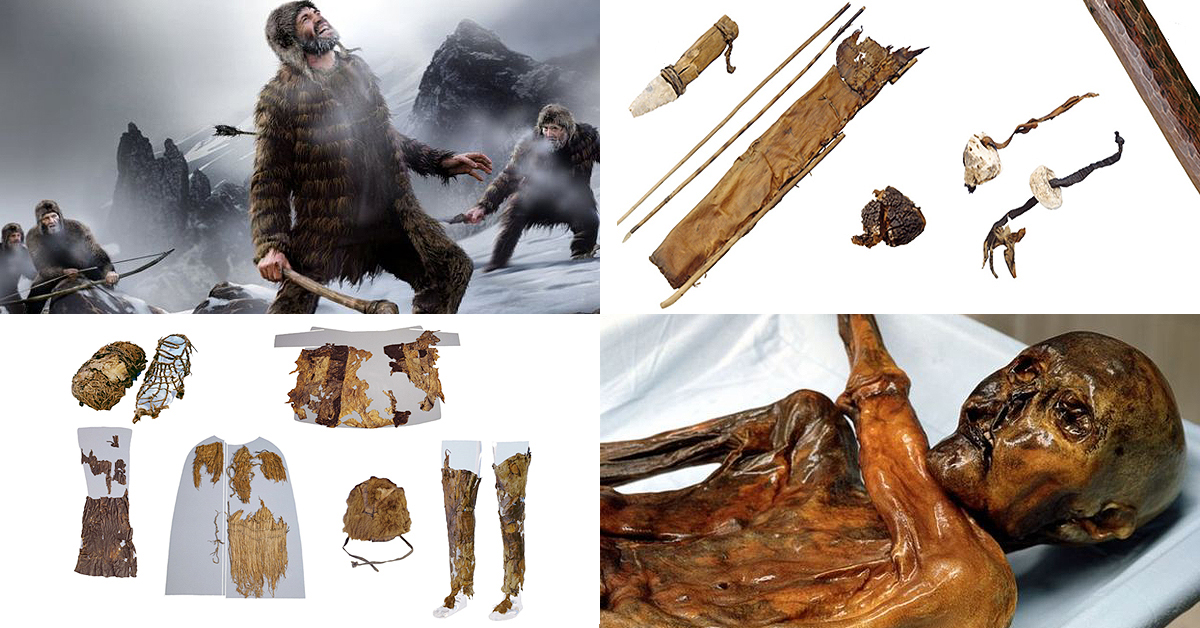


An article by Science reporter Jonathan Webb on BBC News - DNA traces origins of Iceman's ragtag wardrobe - reports that DNA analysis of Oetzi the Iceman's clothes has traced their origin to at least five different species of animal.

Images: Institute for Mummies & the Iceman, South Tyrolean Museum of Archaeology & Science Photo Library
Despite being well preserved and studied, the 5,300-year-old mummy's various leather items had not all been identified at the species level. Now researchers know that Oetzi wore a hat of brown bear skin and carried a quiver made from roe deer. Indeed, the findings, published in Scientific Reports, reveal a mix of wild-hunted animals with sheep, goat and cattle related to modern domestic breeds.
DNA traces origins of Iceman's wardrobe #Oetzi #Iceman #SouthTyrol #Italy https://t.co/EB0UnvqL96 pic.twitter.com/gZdKYPYFU4
— Bradshaw Foundation (@BradshawFND) August 23, 2016
This suggests that Copper Age people chose carefully between different wild and domesticated animals when looking for materials to make their clothes, even though Oetzi's wardrobe may appear to be 'motley' - a coat made from at least four separate goat and sheep hides, suggesting a haphazard or opportunist approach, stitching together whatever scraps of skin were available.
Whether Oetzi's approach to clothing was haphazard or opportunistic, this does prove that he was an agropastoralist; the majority the food and resources that he used were of domestic origin. The paper's first author Niall O'Sullivan, a PhD student at University College Dublin based at the Institute for Mummies and the Iceman in Bolzano, Italy, goes on to state that the Iceman supplemented his living with food from wild sources. His last meal was composed of ibex and red deer. As well as for food, for the manufacturing of leather he also used both wild and domestic animals.
The Iceman's belongings that the team pinpointed were leggings made from goat skin, a shoelace of cow leather, a sheep leather loincloth, a quiver made of roe deer, a fur hat - with straps - made from brown bear and a coat of many fragments, incorporating both sheep and goat skin.
These various leathers were all identified based on mitochondrial DNA - the separate, smaller genome found in the tiny compartments that turn food into energy inside living cells. When Oetzi was discovered in 1991, famously well preserved in the ice of the Italian Alps, this type of ancient DNA analysis was impossible.
Read more about Otzi the Iceman:
Otzi the Iceman reveals clues on Human Migration
http://www.bradshawfoundation.com/news/origins.php?id=Otzi-the-Iceman-reveals-clues-on-Human-Migration
The voice of Otzi the Iceman
http://www.bradshawfoundation.com/news/archaeology.php?id=The-voice-of-Otzi-the-Iceman
by Bradshaw Foundation
Monday 04 December 2023
by Bradshaw Foundation
Friday 30 June 2023
by Bradshaw Foundation
Thursday 06 April 2023
by Bradshaw Foundation
Thursday 24 November 2022
by Bradshaw Foundation
Tuesday 27 September 2022
by Bradshaw Foundation
Thursday 08 September 2022
by Bradshaw Foundation
Tuesday 19 July 2022
by Bradshaw Foundation
Monday 06 June 2022
by Bradshaw Foundation
Friday 11 March 2022
by Bradshaw Foundation
Wednesday 02 March 2022
by Bradshaw Foundation
Thursday 26 August 2021
by Bradshaw Foundation
Monday 16 August 2021
by Bradshaw Foundation
Tuesday 06 July 2021
by Bradshaw Foundation
Thursday 06 May 2021
by Bradshaw Foundation
Thursday 06 May 2021
by Bradshaw Foundation
Tuesday 16 March 2021
by Bradshaw Foundation
Monday 04 December 2023
by Bradshaw Foundation
Friday 30 June 2023
by Bradshaw Foundation
Thursday 06 April 2023
by Bradshaw Foundation
Thursday 24 November 2022
by Bradshaw Foundation
Tuesday 27 September 2022
by Bradshaw Foundation
Thursday 08 September 2022
by Bradshaw Foundation
Tuesday 19 July 2022
by Bradshaw Foundation
Monday 06 June 2022
by Bradshaw Foundation
Friday 11 March 2022
by Bradshaw Foundation
Wednesday 02 March 2022
by Bradshaw Foundation
Thursday 26 August 2021
by Bradshaw Foundation
Monday 16 August 2021
by Bradshaw Foundation
Tuesday 06 July 2021
by Bradshaw Foundation
Thursday 06 May 2021
by Bradshaw Foundation
Thursday 06 May 2021
by Bradshaw Foundation
Tuesday 16 March 2021
Friend of the Foundation











